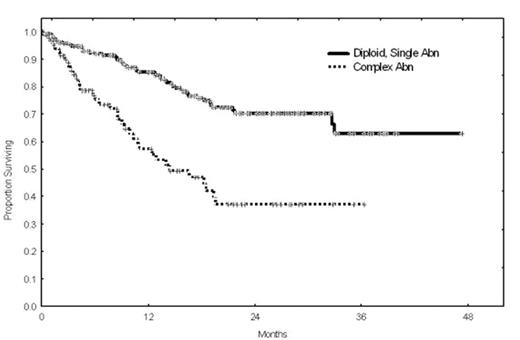Abstract
Recently, several novel prognostic factors have been identified; their significance has been demonstrated in selected patient (pt) populations and retrospective analyses. As a group, previously treated pts with CLL likely have their respective, relevant prognostic factors for clinical endpoints, which may be further impacted by treatment (Rx). We prospectively evaluated the significance of newer prognostic factors: FISH abnormalities (abn) (Vysis CLL panel), IgVH mutation status, ZAP70 expression (flow & immunohistochemistry), CD38 expression (≥30%); as well as traditional factors: conventional cytogenetic analysis perfomed on bone marrow metaphases, age, sex, # prior Rx, refractoriness to alkylating agents (ALK) or fludarabine (FLU), absolute lymphocyte count (ALC), HGB, PLT, β-2 microglobulin (B2M), ALB, LDH, creatinine, and Alk Phos as independent predictors for survival in previously treated pts. The group included 473 previously treated pts seen at M.D.Anderson (10/03–8/07), who were evaluated by bone marrow sampling with conventional and FISH cytogenetic analyses, and the new and traditional prognostic factors described above. The median (range) age was 63yrs(31–87) and # prior Rx was 2(1–13). Other characteristics were: 43% Rai high-risk; 35% FLU-refractory; and 39% ALK-refractory; 74% unmutated IgVH; 54% ZAP70+ (flow); 76% ZAP70+ (IHC); and 68% CD38+. FISH results were: 22% del 17p13, 21% del 11q22, 10% +12, and 48% del 13q14 or no abn by the hierarchical classification. Conventional cytogenetic analysis of bone marrow metaphases demonstrated 25% with a complex karyotypic abn (>1 cell with >1 chromosome abn), 58% diploid, 17% with single clonal abn (>1 cell with 1 abn). Of the 100 pts with complex karyotypic abn, 50% had del 17p13, 28% del 11q22, 6% +12, 9% del 13q14, and 7% had no abn by FISH. Survival was measured from the time of prognostic factor characterization (FISH). The median follow-up time was 10mo(0–47). Univariate analyses identified the following significant (p≤.01) predictors for shorter survival: advanced age, # prior Rx, Rai high-risk, ALK- or FLU-refractory, FISH del 17p13; complex karyotypic abn (Figure 1), unmutated IgVH, high ALC, low HGB, low PLT, high B2M, low ALB, high LDH, and high Alk Phos. Multivariate analysis produced the following model with the following significant (p<.05) independent predictors for survival: ALK- (HR 2.2) or FLU-refractory (1.9), complex karyotypic abn (HR 1.8), PLT (HR 0.99), and ALB (HR 0.35). We previously reported complex karyotypic abn as a significant independent predictor for shorter survival in previously treated patients receiving chemoimmunotherapy (
Author notes
Disclosure:Research Funding: Bayer Healthcare, sanofi-aventis, MemGen, Genitope, Genmab, Sunesis, Abbott Laboratories. Honoraria Information: Celgene.


This feature is available to Subscribers Only
Sign In or Create an Account Close Modal